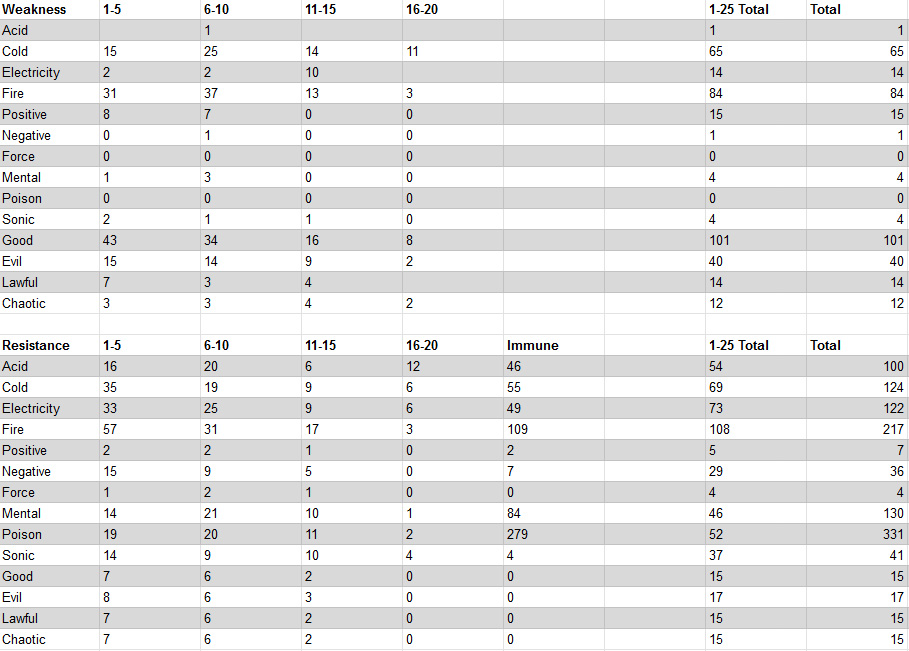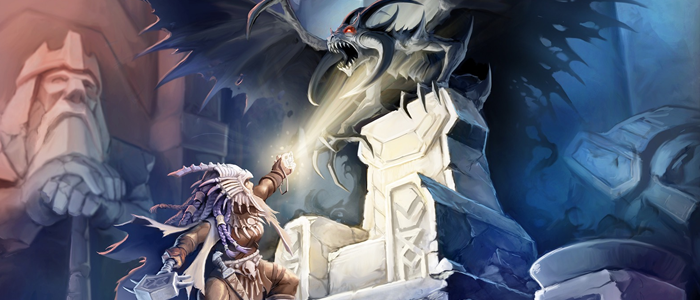Pathfinder 2e Weaknesses, Resistances, and Immunities!
“Am I gonna run into more electricity resistance than fire? Or is fire still the most common in PF2?”
A good friend asked me that this week, and I found myself a little stumped. My instincts told me that fire resistance was more common, but after a quick browse of the Bestiary, it became obvious that it was also a way more prolific weakness. PF2e players tend to forget just how many monsters have immunities, weaknesses, and resistances. It can be easy to overlook, especially if you don’t use Recall Knowledge as much as you should. But like any over-achiever, I wanted to know the exact numbers in all three Bestiaries. And what I found were some fascinating insights into how the proliferation of these game elements spoke to the nature of each of the eight energy types.
Quick Disclosure about this Data
You should pick the energy type that fits your character. But you should also pick the character that best fits the campaign. Nine times out of ten a campaign setting’s environment and the featured enemy is a much better indication of which element to wield. And each element has its own pros and cons: I’d much rather have a fire mage on my journey to the Crown of the World, but someone specializing in Mental damage is probably more useful in an intrigue campaign! Knowing there are slightly more monsters with cold resistance and immunities than acid doesn’t mean acid is always better. After all, this data doesn’t account for monster rarity, blanket type-immunities, or just the fact many of these resistances and weaknesses are only higher and lower because these numbers scale with the creature’s levels. Some players have a character that has whittled down their spell choices from 30 to 2. Others are GMs or even monster designers looking to see which resistances and weaknesses need a little more love. I’ve compiled the data here strictly because I’ve seen it asked more than once, so it’d be convenient to have it all listed here!
Also Note: All energy types are valid! There are 1072 monsters in Bestiary 1, 2, & 3. Even the most commonly resisted energy type only applies to 20% of the monsters in the book, and about half of those are extremely rare and high-level monsters! And, of course, many GMs will also be pulling threats not accounted for in this data, including monsters unique to published adventures or your own campaign!
Methodology
For this data, I looked at the eight energy types, the four alignments, and checked Mental and Poison. Many monsters also have weaknesses and resistances to the three types of weapon damage, all physical damage, and specific materials (especially cold iron). Since martial characters can carry an arsenal capable of switching between these, I found it more important to focus on energy types that can’t be as easily swapped during an encounter. I didn’t count monsters that could resist everything, but I did count monsters who could switch resistances.
Energy Analysis
Acid, Cold, Electricity & Fire: Fire has almost twice as many immune and resistant monsters as Acid, Cold, or Electricity. But it also has the most monsters who are weak to it out of those four energy types. Cold and Electricity almost tie for resistances, but far more creatures are weak to cold. Of course, Electricity has probably the best damage dealing cantrip in the game, and Cold has the least number of practical applications in exploration mode. Acid has less resistant monsters than Electricity or Cold, but only by 20%. And there are almost no monsters weak to Acid Damage!
Force & Sonic Energy: As to be expected, the two classic black-sheep of the energy damage family have the least number of resistances and weaknesses in the game. They remain a solid and consistent source of damage in this edition, especially with Force damage being able to hit incorporeal creatures who are otherwise resistant to almost everything else!
Positive & Negative Energy: These affect pretty much every living and/or undead creature as you’d expect. Note that there are many monsters I didn’t count in this data with immunity to “Necromancy”, which make them immune to the most common spells and effects that deal positive and negative energy damage.
Alignment Damage: Everything that isn’t of an opposing alignment is effectively immune to alignment damage. This hasn’t been accounted for in the data. Good damage is one of the best in the game, as most enemies are evil, very few creatures resist Good damage, and many evil creatures have it as a weakness! But, if you have a choice, you should try to pick an alignment that best matches the most common foe you are likely to encounter in the campaign.
Mental & Poison Damage: Most of the immunity here is from creatures like Constructs, Oozes, and Plants that you’d expect to be immune to Mental damage in the first place. Poison has the most immunities, including Constructs, Elementals, and Undead. The advantage of these types of damage is innate to the effects that grant them. Mental damage tends to be subtle and flexible, usually targeting the saving throw that is easiest to reduce. Poison effectively provides martial characters with an extra boost in damage without a major impact on their action economy and/or multiple attack penalty.
The Data
This is why you are here, right? (Google Sheet Link)







